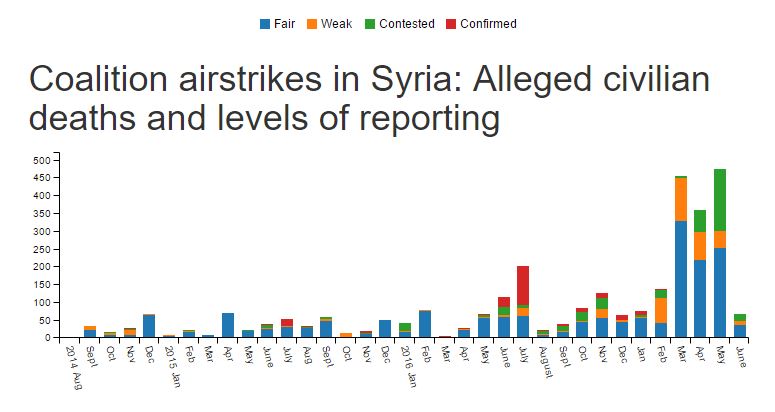As many as 100,000 civilians trapped inside the Islamic State-held city of Raqqa are being given conflicting evacuation instructions according to Coalition statements and local reports, as US-backed ground forces finally assault the city supported by air and artillery strikes.
Kurdish-dominated Syrian Democratic Forces (SDF) started their slow encirclement of Raqqa last November. Artillery and airstrikes have rained down since then killing hundreds of civilians in the near region according to monitors, though the final operation to take the city commenced officially only on June 6th. In a press release published that day, the Coalition stressed that “The SDF have encouraged civilians to depart Raqqah so that they do not become trapped, used as human shields or become targets for ISIS snipers.”
A Coalition spokesperson elaborated that the SDF “have communicated with the citizens of Raqqah through several means, to include leaflets dropped by Coalition aircraft, urging them to evacuate the city if it is safe to do so.”
On May 28th, the monitoring group Raqqa is Being Slaughtered Silently (RBSS) uploaded to social media two such leaflets it said had been dropped over the city. One told residents to use the document as they sought refuge with SDF soldiers. Leaving ISIL-held areas is not without risk, with militants routinely documented firing upon and killing men, women and children attempting to flee.
Another leaflet reportedly dropped by the Coalition instructed civilians to hide the paper and – without telling anyone they were leaving – to approach an SDF soldier with a strip of something white. “This is your last chance,” said the leaflet, translated by an Airwars researcher. “Failing to leave might lead to death. Raqqa will fall, don’t be there at that time.”

The Coalition initially dropped leaflets telling people in Raqqa to flee the ISIL-occupied city – only to reverse its decision days later. This leaflet was reportedly dropped on the city. (Via Raqqa Is Being Slaughtered Silently)
Reversed decision
However only a day after the Coalition’s announcement, officials informed Airwars on June 7th that ground forces had reversed tactics and no longer wanted civilians to leave. “Since transitioning to offensive in Raqqah yesterday, SDF is now encouraging civilians to stay in their homes, shelter in place, and avoid ISIS fighting positions,” said spokesperson Colonel Joseph Scrocca. Earlier efforts, he stressed, had “helped evacuate more than 200,000 civilians from Raqqah.”
“However, as the SDF enters the city, they do not want civilians placed in harm’s way by the fighting so they have asked them to remain indoors and away from ISIS positions,” said Scrocca. The SDF, he added, “are using a variety of technical and non-technical means such as leaflets, radio broadcasts and internet messages.”
Airwars reached out to local monitor Raqqa is Being Silently Slaughtered, which said it was unaware of the new posture and stated that residents were still under the impression that they were best off leaving.
“They dropped these papers and told the people who want to flee to take them and go to SDF areas,” said a member of the group who spoke to Airwars via the organization’s Facebook account. “If they want them to stay, then why did they drop papers and tell them to leave?”
SDF spokesperson Jesper Soder claimed that the leaflets posted by RBSS were not genuine, though he largely conceded that residents had received mixed-messages.
“We have told the ones closest to our positions to try to flee towards us,” said Soder. “And the ones that are far away to stay inside and hide inside. Also flyers have been dropped in Raqqa telling civilians to hide or seek refuge at our positions.”
It was unclear however exactly how the SDF was able to differentiate populations in the city.
“If the Coalition is going to issue directions to civilians, they should be coordinated and consistent,” said Marla Keenan, senior director of programs for the Center for Civilians in Conflict (CIVIC). “Conflicting instructions create even more confusion on the ground in an already confusing and dangerous situation for civilians.”

Airwars has been tracking high civilian casualties in Syria – predominantly around Raqqa – for some months.
It remains unclear exactly how many civilians are still inside Raqqa. Jens Laerke, spokesperson for the UN’s humanitarian agency OCHA, told Airwars that reports indicated some 95,000 people had fled the city, but that between 50,000 and 100,000 civilians remained. The Coalition estimates that roughly 2,500 fighters are lodged among them.
ISIL has systematically put civilians in danger, and the Coalition has repeatedly highlighted the terror movement’s use of non-combatants as human shields in Mosul – a tactic the alliance says could be repeated in Raqqa. Human rights officials caution that the dropping of leaflets and dissemination of other warnings does not change the legal responsibility of the Coalition and SDF to protect civilians caught up in the fighting.
“The presence of ISIS fighters among civilians does not absolve anti-ISIS forces from the obligation to target only military objectives,” said Lama Fakih, Middle East and North Africa director at Human Rights Watch. “The issuance of effective advance warnings of attack to the civilian population do not relieve attacking forces of their obligation to distinguish at all times between combatants and civilians, and to take all feasible precautions to protect civilians from harm.”
The stakes remain incredibly high in Raqqa and its environs, where the likely death toll from airstrikes in recent months surpasses anything Airwars has previously monitored – all before the start of fighting inside the city itself (see graph.)
In the three months leading up to June, researchers at Airwars estimate that over 600 civilians were killed in more than 150 Coalition or SDF attacks. That tally includes a minimum 284 civilian deaths in March, 215 in April and at least 220 in May. Already in the first eight days of June, dozens of civilians have been reported slain in air and artillery strikes.
Coalition data further illustrates the intensifying campaign. In May, the number of declared airstrikes around Raqqa more than doubled from the previous month, from 116 to 289.
According to a spokesperson, “In Syria, over 1,800 munitions were fired [in May] of which approximately 1,000 were in support of operations to isolate Raqqah.” Those Coalition figures also include artillery and rocket strikes, but do not include attacks by allied SDF ground forces.
‘Insufficient precautions’
As reports of casualties around Raqqa mount, there are concerns that the Coalition and its SDF allies are not taking enough care to protect civilians.
At the end of May, the UN’s human rights chief Zeid Ra’ad al Hussein raised alarm at airstrikes in Raqqa and other parts of northeast Syria. The UN pointed to several incidents, including a May 14th strike in Al-Akershi that reportedly killed 23 farm workers, including 17 women.
“The same civilians who are suffering indiscriminate shelling and summary executions by ISIL, are also falling victim to escalating airstrikes,” said Zeid. “Unfortunately, scant attention is being paid by the outside world to the appalling predicament of civilians trapped in these areas.”
According to the Syrian Network for Human Rights, during May the alliance was responsible for more non-combatant deaths in Syria than the Assad regime, Russia, or so-called Islamic State.
A total of 964 civilians were killed in #Syria in May 2017https://t.co/Xfp8qpA7Yz pic.twitter.com/7JlEZtkG0M
— Syrian Network (@snhr) June 2, 2017
Accounts of civilian casualties from airstrikes around Raqqa are often well sourced and, unlike contested reports in other theatres such as Mosul, generally indicate one clear culprit: the Coalition.
For instance, several dozen accounts cite the Coalition for an airstrike on May 21st in Kdeiran village, located in western Raqqa governorate. ISIL-controlled media released a graphic video of the aftermath, but many other sources, including the Syrian Network for Human Rights and the Syrian Observatory also reported the incident. The Syrian Network said that at least 15 civilians were killed, including 4 children. At least nine victims were named by local sources.
In another event, Airwars was able to gather more than three dozen reports of an attack that left at least four civilians dead in Al Suweidiya village on May 30th. A number of outlets concurred that a Coalition strike had hit a house belonging to the Al-Razaj family. Raqqa is Being Silently Slaughtered named four victims: Rima Al-Enezan; Abdul Rahman Hussein Al-Razaj; and Aya Hussain Al-Razaj.
On June 5th, the day before the Coalition announced the start of final operations inside Mosul, its planes allegedly fired on civilians gathered near boats along the Euphrates River, killing at least eleven. Some outlets put the death toll higher and said the civilians were attempting to flee Raqqa – as they had been instructed by the SDF.
Fresh concerns for the safety of civilians were raised June 8th after ISIL released video footage apparently showing the use of white phosphorous shells on the city by US or Coalition forces.
Isis claims US led coalition using White phosphorous in Raqqa video dated June 8 #Syria pic.twitter.com/5Ul5J1c0MH
— Fazel Hawramy (@FazelHawramy) June 9, 2017
How long the fighting in Raqqa will continue remains uncertain. Fabrice Balanche, a visiting fellow at the Washington Institute, estimates that if ISIL is allowed to leave the city – as was the case in nearby Tabaqa – battles could cease in as little as two months. But US Defense Secretary Jim Mattis has since warned that the Coalition plans to annihilate remaining ISIL forces.
“We have already shifted from attrition tactics, where we shove them from one position to another in Iraq and Syria, to annihilation tactics where we surround them. Our intention is that the foreign fighters do not survive the fight to return home to North Africa, to Europe, to America, to Asia, to Africa,” he recently told CBS News.
If the heavily fortified city is instead encircled, cut off and assaulted one neighbourhood at a time, the operation could last far longer, with associated risks for trapped civilians. Operations to capture Mosul in Iraq are still continuing eight months after they first began.
